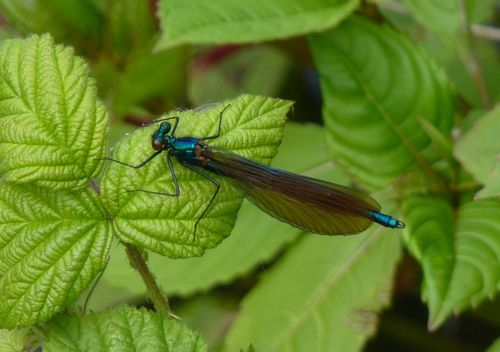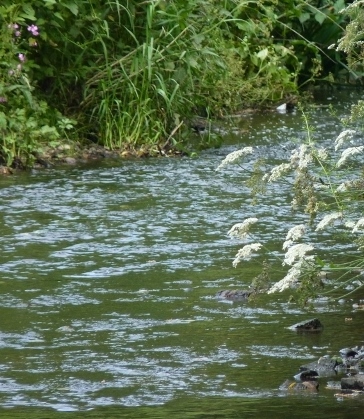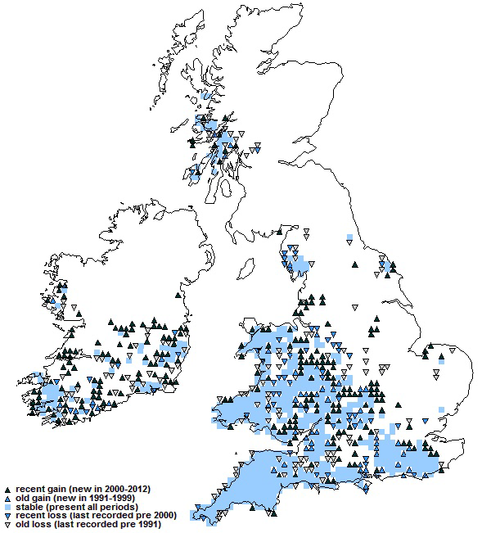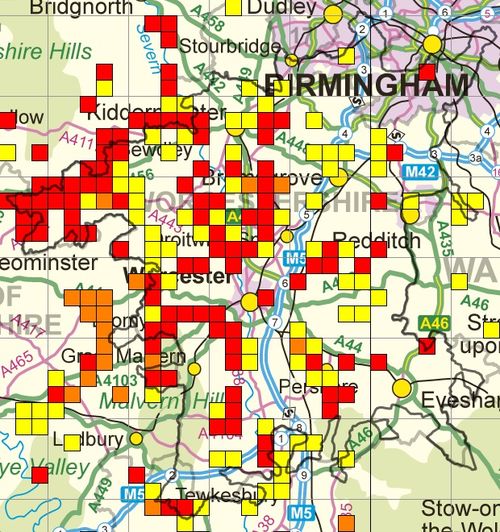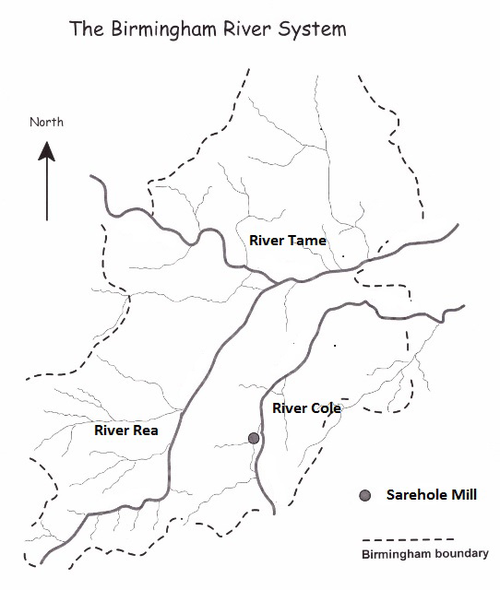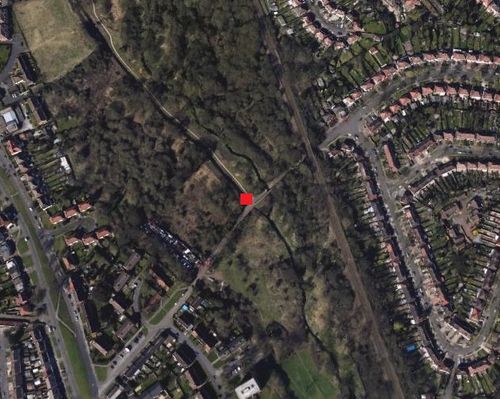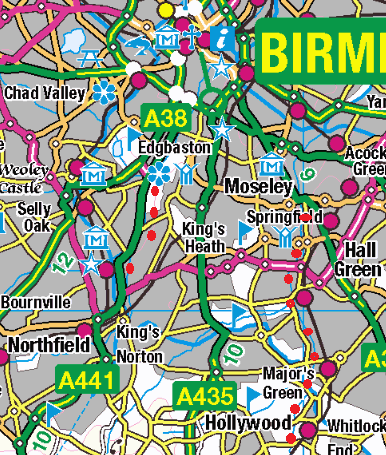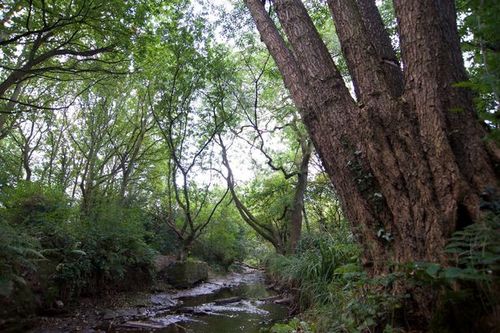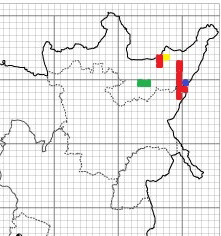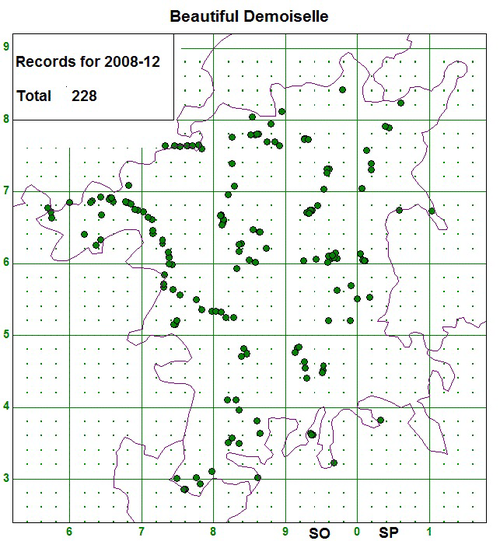The recent colonisation and range expansion by Beautiful Demoiselle Calopteryx virgo along the rivers Cole and Rea in north-eastern Worcestershire VC37
Des Jennings
Change in the status of some British dragonflies - A brief summary
The Atlas of Dragonflies in Britain and Ireland published in 2014 based on fieldwork during the years 2008-12 and including records going back to 1991 revealed a number of surprises relating to newly recorded species in the British Isles and species expanding their range, probably due to climate change: 14 of the 15 hottest years have been in the 21st century (World Meteorological Organisation). For example the Willow Emerald Chalcolestes viridis is a newly established breeding species; the Southern Migrant Hawker Aeshna affinis is trying to gain a toe-hold and the Dainty Damselfly Coenagrion scitulum has been re-discovered after being lost as a breeding species. However, probably the most dramatic colonisation is that by Small Red-eyed Damselfly Erythromma viridulum, first discovered on the east coast in 1999 and now found in much of England, including VC37 (Worcestershire), north to the river Humber and west to east Devon, plus a site in south Wales.
The Atlas also highlighted changes in the behaviour of species established in the British Isles for a long time and have expanded out of regular breeding counties into new areas. Scarce Chaser Libellula fulva is a case in point. It was unknown in VC37 until the first confirmed record in 2004 (Averill 2004), but it has been recorded at a number of sites in recent years throughout the county.
Another species, well-established in western areas of the British Isles, that has shown signs of seeking new areas away from rivers like the Severn or Teme, is the Beautiful Demoiselle Calopteryx virgo (01). C. virgo is a lover of fast flowing streams or rivers and the Cole and Rea fulfil its requirements (02).
As the Atlas illustrates (03), C. virgo has spread eastwards and northwards in recent years, although not dramatically, and new sites within core areas have been colonised. The national change in distribution is mirrored in VC37 (04), where a small expansion in range can be seen, although the north east corner of the county is almost devoid of records.
Two suburban rivers
I have been walking along my local rivers, the Rea and the Cole, for a number of years. Both flow north through the Birmingham suburbs (05) and for some distance run parallel to each other before eventually joining the rivers Tame and Blythe respectively. It has never been difficult to see the close relative of C. virgo, the Banded Demoiselle Calopteryx splendens along these Rivers, however, C. virgo was not one I expected to see because of the urban nature of the rivers, clean though they are, running through most of the southern areas of the city. However, it would appear that by 2011 at least (09) C. virgo was making inroads along the Rea.
My first sighting of C. virgo along the Cole, and the first official sighting, was of a male on the 18th June 2013, not far from the boundary with VC38 (Warwickshire) at Yardley Wood. I did not see any more that year in that area as I was concentrating my efforts at other local sites “new” in 2013 for recording purposes.
A new season and consolidation by Beautiful Demoiselle
The 2014 recording season got off to a good start weather-wise and continued in that vein for most of the summer. I endeavoured to spend more time on the Cole seeking out C. virgo. Naturally I returned to the 2013 site early in the season and, as I had hoped, C. virgo was present in the form of a male on the 13th May. I explored further south, but still just within VC37, and saw more individuals. I even strayed into VC38 and logged more sightings and by the 14th June the mid-May location held four males and three females. I decided to go upstream from my first sighting and see if the Cole held more surprises, but that meant getting to parts of the river through seemingly impenetrable “bush” to investigate likely locations. My hunch proved a good one. At various points along the river I sought out areas blessed with sunny conditions and after a wait I was usually rewarded with C. virgo and, more often than not, a male. Other good vantage points were often road bridges over the river, where elevation benefitted viewing (06).
My most northerly sighting was not far from the Stratford Road, Sparkhill. Upstream of Sparkhill the river deteriorates in quality because of the adjacent industry, but I hope to continue recording further north and east to the extremity of VC37’s recording area.
A total of ten sites where C. virgo was recorded 13th May to 19th June 2014 were from four miles from inner Birmingham to farm land in the Trueman’s Heath area (07).
The River Rea and more records
After my successes on the Cole I felt that the Rea (08) could hold more sites for C. virgo. I had recorded it not far from the River Rea in the Kings Norton area in 2012 and there are two other records, one from 1900 and one during the Atlas period in 2011 in Selly Oak. My observations started near Canon Hill Park and it wasn’t long before a male (predictably) was noted. Other sightings were seen downstream but not as many as along the Cole. Some areas of the Rea are heavily shaded and therefore do not provide suitable habitat so further records are unlikely.
Map (09) illustrates the sightings recorded up to 2014 in 1 km squares. Unlike the River Cole, there were fewer observations over a shorter period. From 24th June to 7th July, four sites held C. virgo covering a distance of 1 mile.
Conclusions
I can only speculate on how recently C. virgo has colonised sites along the Cole and increased along the Rea. It is possible that they have been missed for at least two years at the more difficult observation points along the Cole and given that the record from the early 20th Century along the Rea, lack of recording coverage may well be a factor. However, given the fact that other areas of the country have seen an increase in sightings and a spread into new areas, a number of other factors may well be at work: climate change; an increase in the number of observers during the ‘Atlas’ years (10); and improved habitat.
If we can achieve more thorough coverage with an increased number of observers in under-watched areas, we may make new discoveries and find other species are colonising VC37. We are almost bound to throw up a few surprises and will certainly improve our knowledge of these fascinating insects.
References
Averill, M. 2004, Scarce Chaser Libellula fulva makes a surprise addition to county list. Worcestershire Record 17:17-18
Cham, S., Nelson, B., Parr, A. Prentice, S., Smallshire, D. & Taylor, P. 2014. Atlas of Dragonflies in Britain and Ireland. Biological Records Centre, Wallingford.
Dragonflies of Worcestershire at www.dragonfliesoforcestershire.weebly.com
World Meteorological Organisation http://worldweather.wmo.int/en/home.html
Images
01. A male Calopteryx virgo: in fact the first I saw and photographed along the River Cole at Yardley Wood in June 2013.
02. The fast flowing River Cole, exhibiting a pebbly shoreline and plenty of bankside vegetation.
03. The most up to date map of the distribution of C. virgo in the British Isle at 2012. The black triangles indicate gains during 2000-2012. (Cham et al 2 014). Used with the kind permission of the British Dragonfly Society.
04. Red squares show C. virgo distribution in VC 37 up to 1996: orange squares show additional records up to 2000: yellow squares show additional records up to 2012. Data courtesy of NBN Gateway with thanks to Worcestershire Biological Records Centre" (WBRC being the dataset provider) and "Crown copyright and database rights 2011 Ordnance Survey.
05. Shows the rivers Cole and Rea on their north easterly path to the rivers Blythe and Tame respectively: Sarehole Mill is highlighted near the Cole. Fifteen species of dragonfly were recorded between the Cole and the Millpond in 2014.
06. The site (denoted in red) of the first official record of C. virgo along the River Cole at Yardley Wood in 2013, seen from a road bridge, as was often the case during more extensive recording in 2014.
07. Small red dots indicate the 2014 sites for C. virgo along the rivers Cole and Rea. Contains OS data ![]() Crown copyright 2015.
Crown copyright 2015.
08. The River Rea at Northfield
09 The north-eastern 10 km squares of VC 37, showing 1 km squares occupied by C. virgo. The yellow square is a 1900 record; green squares are 2012 records, blue 2013 and red 2014, which overlap a 2011 record.
10. Map shows the number of records submitted by observers in VC37 during the ‘Atlas’ years. Only a handful of 10 km squares do not have a record for C virgo out of just over thirty possible squares.
